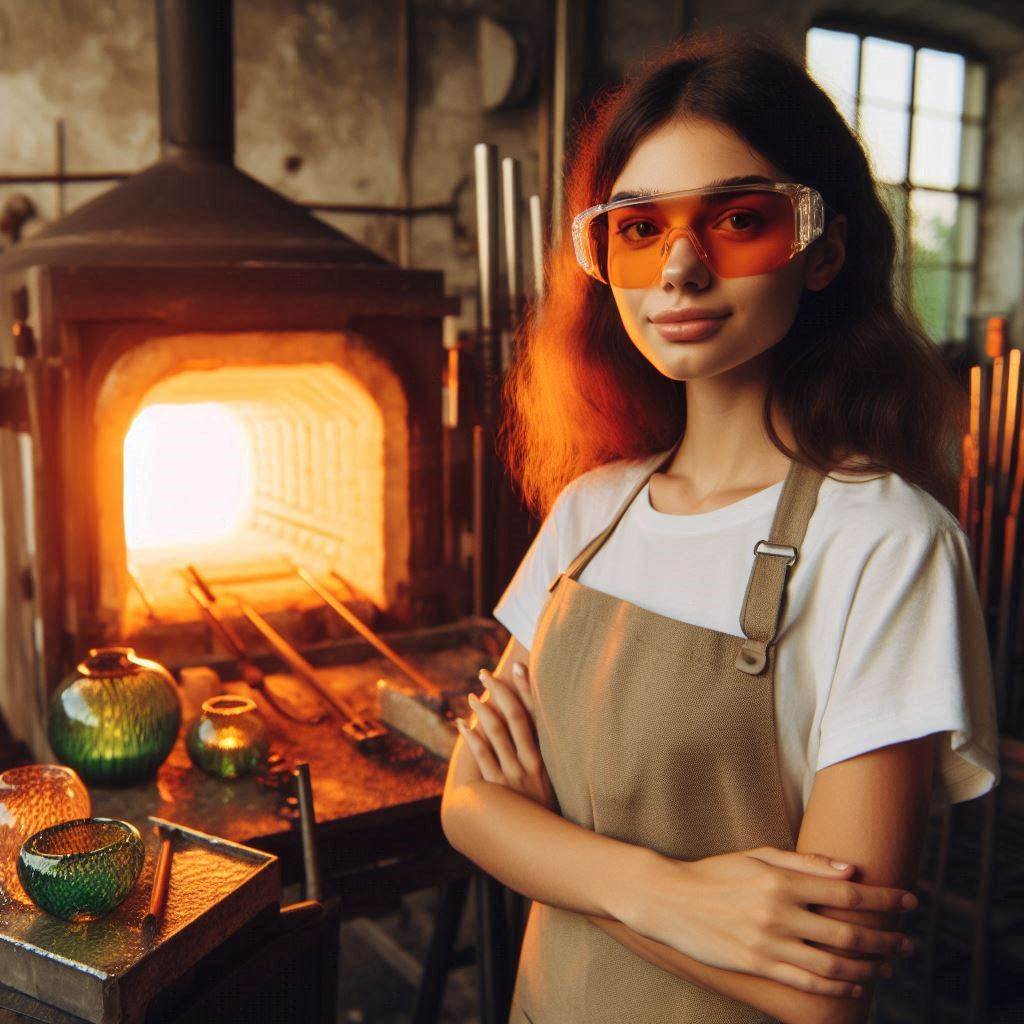Introduction
Glass art courses provide hands-on experience in creating beautiful glass pieces through various techniques.
Understanding what to expect before enrolling can help students make the most of their learning experience.
Glass art courses cover a range of techniques such as glass blowing, stained glass, fusing, and casting.
Students learn how to manipulate glass through heating, shaping, cutting, and assembling different glass components.
By knowing what to expect, students can mentally prepare for the challenges and opportunities that come with learning glass art.
Having a clear understanding of course objectives, materials required, and time commitment can help students succeed in their studies.
Overview of Glass Art Courses
Glass art courses offer a diverse range of experiences and learning opportunities.
These courses cater to various skill levels, from beginners to advanced artists.
Here’s what to expect when diving into the world of glass art education.
Different Types of Glass Art Courses Available
Glass art courses come in various forms, each focusing on different aspects of the craft.
You might encounter courses on stained glass, where you’ll learn to create colorful designs using glass pieces and lead.
Fused glass courses teach you to melt and fuse glass pieces together in a kiln to make intricate designs.
Glassblowing courses introduce you to shaping molten glass using traditional techniques.
Additionally, courses on glass casting and engraving offer specialized skills in creating three-dimensional glass art.
Common Topics Covered in Glass Art Courses
In glass art courses, you’ll explore fundamental topics that are crucial for mastering the craft.
Courses typically cover the history of glass art, providing a context for contemporary practices.
You‘ll learn about different types of glass and their properties, which is essential for selecting the right materials for your projects.
Safety procedures are also a key focus, ensuring you handle materials and equipment properly.
Additionally, courses often include design principles, teaching you how to plan and execute your art pieces effectively.
Skills and Techniques Taught in Glass Art Courses
Glass art courses equip you with a range of skills and techniques.
Transform Your Career Today
Unlock a personalized career strategy that drives real results. Get tailored advice and a roadmap designed just for you.
Start NowYou‘ll gain proficiency in cutting and assembling glass, learning how to create precise and clean edges.
Techniques like soldering for stained glass and layering for fused glass will be taught.
In glassblowing, you‘ll master the art of manipulating molten glass and forming various shapes.
Courses also cover finishing techniques such as polishing and annealing to enhance the quality and durability of your creations.
Each skill is designed to help you develop a unique artistic style.
By engaging in glass art courses, you‘ll immerse yourself in a creative journey, gaining both technical expertise and artistic inspiration.
Read: Art and Design Trends in 2024: What‘s Hot?
Curriculum and Syllabus
Understanding the curriculum and syllabus of glass art courses is crucial for prospective students.
It provides a detailed breakdown of the course content, allowing students to assess if the program aligns with their interests and goals.
Detailed breakdown of course content
The curriculum outlines the topics that will be covered in the course.
This may include glassblowing techniques, glass fusing, stained glass, kiln-formed glass, and more.
Understanding the breakdown of course content helps students gauge the depth and breadth of the program.
Importance of understanding the curriculum before enrolling
Before enrolling in a glass art course, it is essential to review the curriculum to ensure that it meets your expectations.
Understanding the course content will help you determine if the program offers the specific skills and knowledge you are seeking.
Examples of specific projects or assignments
Some glass art courses may include specific projects or assignments that allow students to apply their skills and creativity.
For example, students may be tasked with creating a glass sculpture, designing a stained glass window, or experimenting with different glass techniques.
These projects not only help students hone their skills but also showcase their artistic talents.
Read: Glass Art: Finding Your Unique Style
Instructors and Teaching Method
Qualifications of Instructors
Glass art courses often feature instructors with specialized qualifications.
Many instructors hold degrees in fine arts or a related field.
Transform Your Career Today
Unlock a personalized career strategy that drives real results. Get tailored advice and a roadmap designed just for you.
Start NowThey frequently have extensive experience working with glass, such as in studios or as professional artists.
Some instructors might have additional certifications or training in specific glass techniques.
Their expertise ensures that students receive high-quality instruction and insight into the craft.
Instructors may also have exhibited their work or received awards, adding credibility to their teaching.
This diverse background helps students learn from seasoned professionals who understand both the art and industry.
Teaching Methods Used in Glass Art Courses
Teaching methods in glass art courses vary but often include hands-on practice and demonstrations.
Instructors typically begin with foundational techniques, such as cutting and shaping glass.
They then advance to more complex processes like kiln-firing and glassblowing.
Classes may include live demonstrations, where instructors show each step in real-time.
Students often work on projects that integrate these techniques, receiving feedback along the way.
Some courses incorporate multimedia resources, like videos and tutorials, to complement hands-on learning.
This blend of practical and theoretical instruction helps students grasp the nuances of glass art.
Student-Instructor Ratio and Individualized Attention
Student-instructor ratios in glass art courses can significantly impact the learning experience.
Smaller class sizes often allow for more individualized attention.
Instructors can offer tailored feedback and guidance, helping each student develop their unique style.
This personalized approach ensures that students receive support in areas where they may need improvement.
It also allows instructors to address specific interests and goals of individual students.
Smaller groups foster a more interactive and engaging environment.
In contrast, larger classes might limit direct interaction but can still offer valuable group learning experiences.
Overall, a balanced ratio enhances the educational experience in glass art courses.
Transform Your Career Today
Unlock a personalized career strategy that drives real results. Get tailored advice and a roadmap designed just for you.
Start NowRead: The Science Behind Glass Art and Design

Resources and Materials
When enrolling in glass art courses, it is essential to understand the resources and materials required for the program.
Knowing what to expect in terms of tools and materials can help you prepare adequately and make the most out of your learning experience.
Overview of materials and tools used in glass art courses
One of the primary materials used in glass art courses is glass itself.
This can come in various forms, such as sheets, rods, or frits.
Students will learn how to cut, shape, and manipulate glass to create different artworks.
In addition to glass, students will also need access to various tools and equipment.
Common tools used in glass art courses include glass cutters, pliers, grinders, and soldering irons.
These tools are essential for cutting, shaping, and assembling glass pieces.
Availability of resources such as kilns, glass cutters, etc.
Most glass art courses provide access to specialized equipment such as kilns for fusing glass pieces together.
Kilns are used to heat up glass to high temperatures, allowing the pieces to melt and fuse together.
Having access to a kiln is crucial for certain glass art techniques.
In addition to kilns, students will also need access to glass cutters for precision cutting, pliers for bending and shaping glass, and other tools specific to glass art.
These resources are typically provided by the course institution, but students may also need to invest in their tools for practice outside of class.
Additional costs for materials not included in tuition
While most glass art courses provide basic materials such as glass sheets and tools, some specialty materials may not be included in the tuition fees.
For example, if students want to experiment with different types of glass or colors, they may need to purchase these materials separately.
It is essential for students to budget for additional costs such as specialty glass, molds, or other materials not included in the course fees.
Understanding these additional costs can help students plan their budget accordingly and fully explore their creativity in the course.
All in all, enrolling in glass art courses can be a rewarding experience for anyone interested in the medium.
By understanding the resources and materials required for the program, students can better prepare themselves for the learning journey ahead and make the most out of their glass art experience.
Transform Your Career Today
Unlock a personalized career strategy that drives real results. Get tailored advice and a roadmap designed just for you.
Start NowRead: Art and Design Careers: What You Need to Know
Studio Environment
Description of Studio Space and Facilities
Glass art courses often take place in specialized studios designed for safe and effective crafting.
These studios usually feature dedicated workstations equipped with essential tools.
Expect areas for cutting, shaping, and fusing glass, along with kilns for heating and melting.
Safety equipment, including goggles, gloves, and ventilation systems, is also provided.
Workspaces are typically organized to prevent cross-contamination of materials and to ensure easy access to tools and supplies.
Importance of a Conducive and Safe Environment for Glass Art
A well-designed studio environment is crucial for successful glass art creation.
Safety is paramount due to the use of high temperatures and sharp materials.
Proper ventilation helps remove harmful fumes from glass and adhesives.
An organized space reduces the risk of accidents and enhances focus.
A clean and well-lit environment allows artists to work efficiently and accurately, minimizing errors and improving overall quality.
Any Specific Studio Rules or Guidelines for Students
Studios often have specific rules to maintain order and safety.
Students must adhere to proper safety gear usage, including goggles and gloves.
Only authorized individuals may operate kilns and other specialized equipment.
Clean-up procedures are essential to prevent accidents and maintain a clutter-free workspace.
Proper disposal of glass shards and chemical waste is required.
Following these guidelines ensures a safe and productive environment, allowing students to focus on their creative process.
In summary, the studio environment for glass art courses is thoughtfully designed to support both safety and creativity.
A well-equipped and organized space, combined with strict adherence to safety rules, fosters an ideal setting for mastering glass art.
You Might Also Like: How to Start a Career in Game Design
Transform Your Career Today
Unlock a personalized career strategy that drives real results. Get tailored advice and a roadmap designed just for you.
Start NowStudent Expectations in Glass Art Courses
Time Commitment Required for Glass Art Courses
Glass art courses demand a significant time investment.
Most courses require students to commit several hours per week.
Depending on the course, students may spend 5 to 10 hours weekly on practical work and theory.
Beginners should expect to dedicate additional time for practice outside of class.
Advanced courses may involve longer hours for more complex projects.
Consistent attendance and punctuality are crucial for mastering techniques.
Balancing course requirements with personal schedules ensures a productive learning experience.
Expectations for Participation and Engagement in Class
Active participation is essential for success in glass art courses.
Students should engage in discussions, ask questions, and collaborate with peers.
Each class session builds on the previous one, making consistent involvement important.
Students are expected to contribute to group projects and share insights.
Engaging fully helps in grasping intricate glass art techniques.
Being prepared and attentive during demonstrations will enhance learning.
Your enthusiasm and willingness to experiment will reflect positively in your work.
Opportunities for Feedback and Improvement
Feedback is a vital component of glass art courses.
Instructors will provide constructive critiques to guide your progress.
Students should seek and embrace feedback to refine their techniques.
Many courses offer regular reviews and one-on-one sessions with instructors.
Peer reviews also play a role in learning and improvement.
Embrace all feedback as an opportunity to enhance your skills.
Transform Your Career Today
Unlock a personalized career strategy that drives real results. Get tailored advice and a roadmap designed just for you.
Start NowUtilize critiques to address weaknesses and build on strengths.
Regular reflection and adaptation based on feedback will lead to significant growth in glass artistry.
By understanding these expectations, students can better prepare for the demands and opportunities of glass art courses.
Commitment, active engagement, and openness to feedback are key to a successful and rewarding experience.
Conclusion
Glass art courses offer a unique opportunity to explore creativity and craftsmanship.
In these courses, you’ll dive into various techniques like stained glass, fused glass, and blown glass.
You’ll learn to handle tools safely, understand different types of glass, and master fundamental skills.
Expect hands-on projects that let you create stunning pieces, whether you‘re a beginner or an experienced artist.
Being well-prepared before enrolling in a glass art course is crucial.
Research different programs to find one that aligns with your interests and skill level.
Check course reviews, instructor credentials, and material costs.
Understanding what each course offers will help you make an informed decision and set realistic goals for what you hope to achieve.
Entering the world of glass art through these courses can be both exciting and rewarding.
Embrace the learning process and be open to experimenting with new techniques.
Glass art is not only about creating beautiful pieces but also about exploring your artistic expression.
Courses provide the guidance and support needed to refine your skills and unleash your creativity.
Take the plunge and discover how glass art can enrich your artistic journey.
[E-Books for Sale]
The Big Book of 500 High-Paying Jobs in America: Unlock Your Earning Potential
$19.99 • 500 High-Paying Jobs • 330 pages
Explore 500 high-paying jobs in America and learn how to boost your career, earn more, and achieve success!
See All 500 High-Paying Jobs of this E-Book
1001 Professions Without a Degree: High-Paying American Jobs You Can Start Now
$19.99 • 1001 Professions Without a Degree • 174 pages
Discover 1001 high-paying jobs without a degree! Unlock career tips, skills, and success strategies for just $19.99!




